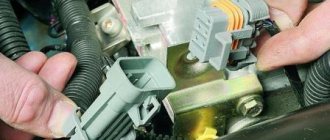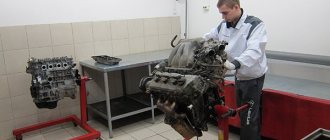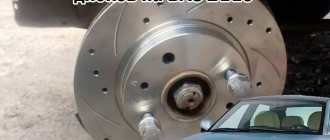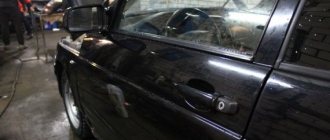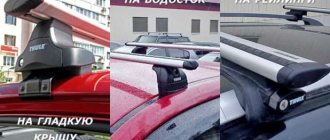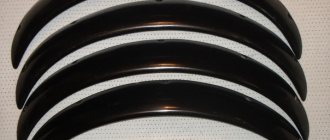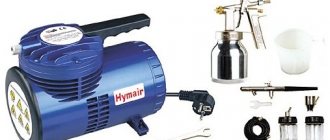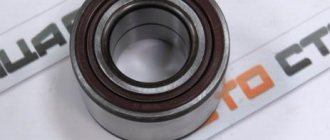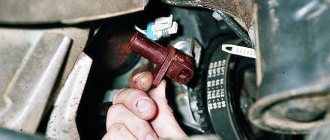The most important thing for ensuring safety when driving a car is, without a doubt, the braking system. And the condition of the working surface of the brake discs greatly affects the performance of the entire system. The average service life of a brake disc is about 70 thousand km. The car has a much longer service life. Therefore, the need to replace or repair these parts appears from time to time in the life of every car owner. In cases where the defects that arise are minor and are not associated with temperature deformation, excessive wear or cracking, turning the brake discs yourself without removing them is an inexpensive repair method.
When is a groove necessary?
Grooving, as well as their replacement, should be done only in pairs standing on the same axis. Otherwise, the difference in braking forces on the right and left will tend to turn the car.
Signs of need for grooving:
- Wave-shaped work surface.
- Scouring on the working surface.
- Excessively rapid wear of brake pads with the same driving style. On average, a set of brake pads lasts for 30 thousand km.
- The brake pedal shakes during braking.
Several ways of grooving without removal
Whatever method of turning brake discs you choose, before you begin, make sure that their thickness is greater than the maximum permissible and that they are not cracked. If they are too thin or have cracks, don't risk repairing them. Better buy new ones. Grooving is the leveling of working surfaces using a cutter,
and the methods proposed below are grinding brake discs without removal.
- There are special units for grinding brake discs without removal. But I think you will agree with me that it is not worth buying a unit just to grind a couple of discs. It will be cheaper to completely update the brake system.
- If the disks are on the drive axle. You will need a flat wooden block measuring 30x15x5 cm and several sheets of sandpaper with coarse abrasive grain (for example, No. 40) on a fabric base. Using sandpaper and a block is preferable to using an abrasive wheel for sanding. Because the working surface of the abrasive wheel will soon cease to be flat after the start of grinding. And the plane of the sides of the block will not change during operation. Don't forget to change the sandpaper - this will speed up the sanding process and improve its results. Raise the car with a jack and put some kind of insurance under it. Remove the wheel, brake caliper and brake disc boot. Hang the caliper higher so it doesn't interfere. Start the engine, put the gear in gear, and adjust the rotation to your liking. Lay a sheet of sandpaper with the abrasive down, place a block on it with the wide side, and bend the edges of the sheet protruding from under the block upward. Press the resulting structure alternately with its wide edge against the working surfaces of the brake disc. Do not try to press it harder, it is better to move the point of contact all the time.
- Brake mechanisms located on a non-driving axle are ground without removal using the same device made from a block and a sheet of coarse sandpaper. Only it will not be the disk that will move, but the block with sandpaper. It will be moved by the strength of your hands. But to tell the truth, doing this without removing the disk is very inconvenient; things will go much faster if you remove them and put them on the workbench.
- Grinding brake discs on the go. This method is suitable for restoring disks located on both the drive and driven axles. But it is suitable for eliminating only minor defects. It will not be able to eliminate the result of severe temperature deformation. First, special devices should be made from old brake pads. To do this you need a grinder with a diamond cutting disc. And also an abrasive cleaning disc for it. It is necessary to cut two wedge-shaped segments from the grinding wheel. Make two recesses in the old brake pads in accordance with the shape of the wedge fragments. Their depth should be a few tenths of a millimeter less than the thickness of the abrasive inserts, so that the latter, after installation, rise above the surface of the pads.
Insert the sectors into the recesses, having previously lubricated them with some kind of glue so that they do not fall out. Install the resulting “abrasive pads” into the caliper instead of the standard ones. To sharpen working surfaces, you need to drive from 5 to 10 km, braking periodically. Plan your route to avoid sudden braking or slowing down on bumpy areas. During the trip, monitor the result of grinding. The bead formed around the perimeter of the disk can be removed after the end of the trip with an ordinary file with a large notch.
After leveling the working surfaces, it would not hurt to treat them with finer-grained sandpaper in order to reduce the depth of the marks. You should not immediately use fine-grain sandpaper, because it will make the surface less smooth and the surface will be smooth, but wavy.
Where to look for a fault
- The beating of the front discs is often reflected not only into the pedal, but also into the steering wheel.
- The rear beating is better felt through the vibrations on the body.
- The front mechanisms more often suffer from thermal deformation, since they bear the main load during braking, therefore, they heat up more. Deformation occurs as follows. When braking, the disc heats up and expands evenly. Water that gets onto a certain area quickly cools it, and as it cools, it shrinks and warps the entire part.
- The rear ones are more susceptible to corrosion. Since, due to their low load, water that gets on them does not dry out for a long time.
The car's brake system requires regular maintenance. In particular, this applies to replacing brake pads, inspecting discs for defects, replacing fluid, etc. But this is not always done on time or at all. Many people turn to service stations only in case of obvious malfunctions. But all this can be avoided if you change the pads in a timely manner and do not forget to sharpen the brake discs.
Groove without removal
Modern industry produces special equipment that makes it possible to perform work directly on the car without removing it. This approach is justified. After all, a wheel hub rotating on bearings certainly provides the necessary conditions for precise machining of the part.
Replacing brake discs. What do you need to know? - there is more useful information here.
Is it worth purchasing a machine for turning brake discs, the cost of which is at least 100 thousand rubles? for your own needs, you will have to decide for yourself. You will have to act in the following order:
- We install the car on a strong and rigid support. A jack will not work here.
- We remove the wheel.
- We dismantle the caliper and clean the disc from foreign contaminants, at the same time making sure that it rotates freely.
- We install a special adapter on the hub and accurately center it, connecting the rest of the equipment to it.
- We position the cutter(s) strictly perpendicular to the wheel axis.
- We turn on the machine and, after waiting until it spins the hub to the required speed, we process the surface of the part.
Taking into account the fact that on most models of this type of machines most of the settings do not take much time, the work is greatly simplified. But, obviously, in the absence of special equipment, the question of how to groove brake discs without removing them with your own hands loses all meaning.
Trust but check
Taking into account all of the above, it is better to entrust the work to professionals who have the necessary equipment at their disposal. But even here, car owners can expect pitfalls. For example:
- You cannot work on the drive axle of a vehicle without dismantling the part or disconnecting the drive shaft from the wheel. Failure to comply with this rule can lead to breakdown of both the processing machine and the transmission of the machine being serviced.
- To achieve the required roughness parameters of the working surface, the capabilities of an ordinary cutter are quite sufficient. Therefore, the statement that the car will have diamond-cut discs is most likely an attempt to get more money from the owner. There is no real need to use diamond cutters.
- Before starting processing, be sure to make sure that the part is within the acceptable dimensions. Otherwise, you may waste your energy, time and money.
But if you do everything correctly, you can save money by breathing a second life into parts that still retain their service life.
About car brake discs
Typically, manufacturers indicate the service life of a particular serviced unit. That is why it makes no sense to talk about specific numbers. On some cars the pads last 10-15 thousand kilometers, on others they last 50 or more. This also applies to disks. If they are of high quality, then they can easily last 100-150 thousand kilometers, provided that the entire system is in good working order. If the caliper guide jams and the pad does not move away from the disc, then it is quite logical that the entire assembly will heat up, and the discs and pads will not only be subject to increased wear, but may also fail due to overheating.
Boring brake discs without removing them – when does it become necessary?
This unit can rightfully be called the main element of the disc brake, to which all the efforts of the actuator are applied. As you know, the main principle of operation of modern braking systems is friction; it occurs between the disc and the pad and helps slow down the rotation of the car’s wheels and bring it to a complete stop.
The braking system, for a number of reasons, undergoes significant loads, this is facilitated by the road surface that is far from ideal, and, of course, extreme situations that a motorist can quite often encounter on the road, driver inexperience, high air humidity, which contributes to corrosion, and rare use of the vehicle. funds, etc.
During sudden braking, the discs heat up to very high temperatures, vibration occurs, and, as a result, the part wears out and the geometry of the disc itself is disrupted. Its surface becomes uneven, and this can lead to rapid failure of even new brake pads. You can understand that this element of the brake system is no longer suitable for use by the following signs:
- there is a beating of the brake pedal during braking;
- When driving, the steering wheel wobbles.
Sharpen or change?
Some people are in favor of sharpening brake discs, while others are only inclined to replace them. Here you need to look at the situation. If the disk is erased, then whether you sharpen it or not, it will no longer perform its function correctly. When the wear is insignificant, but during braking there is such an effect as beating in the steering wheel or brake pedal, then a groove is quite acceptable. And again, in the absence of mechanical defects in the form of cracks, etc.
That is why it is not possible to answer the question posed unambiguously. There are often reviews that the groove gives only a short-term effect and can only be saved by a full replacement paired with the pads. This is partly true, but not always. Let's take a closer look at how to properly sharpen brake discs. Today there is a lot of equipment and various technologies that allow this to be done not only quickly, but also efficiently.
Types and processing technology
To eliminate defects on a disk with your own hands, there are two processing technologies. The first of them is boring, which is produced to increase the diameter of its working surface. This procedure helps to get rid of the bead that appears when the friction linings of the pads do not cover the entire area of the disc during braking.
The second processing technology is grooving, which is done to eliminate surface defects: the resulting layer of rust or scale, uneven wear in the form of deep grooves. In this case, it is necessary to take into account the size of the layer to be removed based on the minimum permissible thickness recommended for a given brand of brake discs.
In the recent past, there was only one way to eliminate defects with your own hands on these brake elements - processing them on a stationary lathe.
To do this, they had to be removed from the car first. In this case, it was very difficult to comply with the necessary balancing parameters when eliminating defects. But there were specialists who dealt with this - like those in this video.
Now there are technologies and special machines that allow you to do this without removing the front and rear discs from the car.
With such equipment it is very easy to maintain the necessary balancing and the required thickness of the working surface, because on it these parameters are set both manually and automatically. This can be seen more clearly in the attached videos.
Express grooving of brake discs without removal
As the name implies, in this case there is no need to dismantle the unit being repaired from the car. That is why such a groove is performed extremely quickly, and is not inferior in efficiency to a full-fledged repair on a lathe. Many modern service stations are equipped with such stands. To perform the work, you only need to remove the wheel. Next, a special unit is installed on the studs; its block is brought directly to the plane of the disk.
The grooving process itself takes approximately 10-15 minutes. Therefore, it will take no more than one hour to complete the work in a circle. Cutters for grooving brake discs on the machine block are installed on both sides. This allows you to significantly reduce runout during the operation. True, this method also has its disadvantages. The main disadvantage is the impossibility of turning discs with a braking element such as a handbrake.
Do-it-yourself grooving of brake discs, can it be done without removal or is it still necessary to remove it?
The surface of the brake discs wears out when braking. This often happens unevenly. One of the ways, in case of defects, to extend their performance with your own hands, is to re-groove the brake discs. To carry out this procedure efficiently, it is worth understanding what signs exist that indicate defects in the brake discs. And also: why do you need a groove, how can you do it yourself, types and technology for processing these spare parts, machines and equipment necessary for the work.
About the cost of work
Much depends on the location of the repair and its method. In many car services you will see different price tags, but at the same time everyone will praise the quality of the work performed. It is worth noting that turning brake discs without removing them will cost a little less, since the craftsmen will not have to unscrew the extra nuts. Also, the cost of services varies depending on the class of car:
- domestic passenger car - 700 rubles per disc;
- foreign car - 1,000;
- business class foreign car - 1,100;
- SUVs - 1,200;
luxury cars (sports) - 1,500.
Machine for turning brake discs
The equipment used to carry out the work plays an important role. Today, many car service centers use portable stands that allow grooving without removing the disc. Nevertheless, stationary lathes have not yet been canceled. They are more functional, and if a professional works, then the result obtained is much better. The machine for turning brake discs allows you to work in three planes. That is, the sides where the pads are adjacent and the place where they press against the hub are machined. At the end you will have a perfectly flat disc, and you can forget about beating during braking like a bad dream.
The most popular machine today is PRO-CUT, costing approximately 200,000 rubles. It is considered professional and allows you to sharpen the disc without removing it from the hub. But if possible, it is better to change it, as a last resort - re-grooving the brake discs. The price of the service today is constantly increasing. In large cities it can reach 3,000 rubles with checking for runout, etc. However, this is a rather expensive procedure.
Do-it-yourself technology for turning brake discs at home
Hello to all motorists and just car enthusiasts! Today we have a rather important topic for discussion, since the agenda is to turn brake discs with your own hands.
Brake discs are one of the key elements of the entire braking system. The safety of the driver, his passengers and other road users directly depends on what happens after pressing the brake pedal, whether the pad presses against the disc and is able to stop the movement of the vehicle.
Today we’ll talk about how to remove the wear and whether you can try to repair a car brake disc with your own hands, at home. In many ways, the same recommendations apply to drums. If you have your own opinion on this matter, I look forward to your feedback in the comments.
Can I do it myself?
There is a corresponding section in the operating and repair manual for VAZ family cars. It clearly and clearly states that grooving can be done in a garage without special equipment. For example, you can remove a shoulder that has formed as a result of disc wear or the use of hard pads using a file. To do this you need to perform the following steps:
- jack up the car and remove the wheel;
- start the car and engage 4th or 5th gear;
- Using a file or a coarse-grained emery disc, the bead is removed first on one side and then on the other.
Of course, this is only relevant for the axis that is the drive. In addition, it is not recommended to do this on foreign cars; it is better to just take it and replace the disks with new ones. Where to sharpen brake discs? It is best to go to a proven service station, where you have already applied more than once. It is also advisable to first familiarize yourself with the cost of the work. Some services charge too much for grooving. Perhaps they do quality work there, although this is not a fact. Too cheap is also not good. It is likely that they neglect quality and deceive customers.
Summarize
Sometimes there is no point in grooving. As noted above, today there are a huge number of Chinese brake discs. It is worth noting that not all of them are of poor quality. You can also pay attention to European analogues. Reasonable price tag and fairly good metal. Try not to brake at high speed in puddles, because overheating and sudden cooling often lead to bending of the brake disc.
The car's brake system is constantly in use; its parts such as pads and discs regularly experience overload and extreme heat. As a result, the metal is deformed and a very noticeable beating appears during braking. Grooving brake discs is necessary in cases where they are not yet very worn out and require straightening rather than replacement.
Modern equipment allows this operation to be performed without removing parts that require alignment; American manufacturers have developed a special Pro Cut stand. The technology allows you to significantly save time on correcting defects, while you can guarantee that the repair will be performed with 100% high quality, but only if the correct diagnosis is established.
Grooving on a lathe
Not everyone can use such equipment. A lathe, which has the necessary accuracy and has dimensions that allow it to process large-diameter parts, sometimes costs more than a car. There is no point in buying it to periodically solve a narrow range of problems.
But even if you have access to equipment with the necessary parameters and you have the appropriate skills, turning brake discs or drums without making special equipment will be impossible.
The fact is that it is impossible to install the part on the machine with the required accuracy simply by spreading the chuck jaws in the central mounting hole. We will have to act differently. Have to:
- Make a special mandrel that matches the shape and size of the wheel hub and has a shank that can be clamped in the chuck. The accuracy of the radial and axial runout of the mandrel should be no more than 0.03 mm.
- Attach the disk or drum to the mandrel (for this you can use the standard fastening system), and then install the mandrel itself into the cartridge.
- Having installed a cutter of a suitable size, groove the working surface of the disk or drum. Runout parameters should not exceed 0.05 mm with surface roughness Rz
In the case of drums, this approach is quite justified. But if we are talking about turning brake discs, then a lathe is not the best way to solve the problem. Fortunately, there are other methods.
Service life of brake system parts, disc grinding methods
Like all components and mechanisms in a car, parts of the brake system (TS) are subject to wear; they have a certain service life set by the manufacturer. On average, pads last from 20 to 50 thousand km, brake discs (BD), as a rule, last twice as long. But the resource may be different, it depends:
- on driving style;
- weather conditions;
- quality of materials;
- compliance with standards during repairs.
With frequent braking and sudden pressing of the brake pedal, parts wear out more intensely, heating causes deformation of the brake pedal, and because of this, the brake pads also work unevenly. Also, the service life of pads and discs is reduced when the car is used in wet weather; non-original spare parts of dubious manufacture do not last long.
It is advisable to replace TDs if their working surface is worn beyond the established norm, or the spare parts themselves are inexpensive. Of course, you can always buy new brake discs, but there is no absolute guarantee that the runout during braking will not disappear, since the parts are of different quality, or the cause of the defect may be hidden in something else (for example, dirt has accumulated between the disc and the hub, the hub itself deformed).
Known methods for grooving TD:
- on a lathe;
- in garage conditions on an emery machine;
- independently using an emery wheel directly on the car;
- using Pro Cut equipment.
The second and third methods do not guarantee good results, and are most often used in emergency cases, when you only need to drive for a while, then you will still need to carry out better repairs. Grooving on a lathe gives better results, but it does not take into account the fact that the defect may be hidden in other parts. Diagnostics and repair at the Pro Cat stand is the most reliable method of getting rid of vibrations in the brake system; the only disadvantage of such a solution is that the financial investment is not always justified. In car services, such work is not cheap, sometimes the cost of repairs exceeds the cost of the spare parts themselves.
Grooving brake discs with your own hands, how to restore them without removing them
Good day, dear motorists! And again we return to one of the main components of the car’s braking system – brake discs. Brake discs, along with brake pads, are the last element of the braking system that carries out the process of braking and stopping the car.
That is, everything: the brake pedal, the brake master cylinder, the brake wheel cylinders, the entire work of this system is aimed at the moment of truth - when the brake pads compress the brake disc and the car stops or slows down.
It would be completely unnecessary to remind you that serviceable brake discs are our chance to avoid an accident. This means that timely maintenance and repair of brake discs is a priority.
Today we will talk about one of the repair methods - grooving and grinding brake discs. To determine their condition during daily use, there are proven traditional diagnostic methods.
Diagnostics of serviceability of brake discs
Preliminary diagnostics of the brake system has a number of specific parameters, knowledge of which allows the driver to notice a brake malfunction in time.
- the brake discs began to heat up;
- when braking, you feel vibration in the steering wheel or brake pedal;
- A visual inspection allows you to see traces of deep rust or mechanical damage to the brake disc.
All this suggests that the time has come for repairs - the brake discs need to be polished. This is in addition to the fact that there are manufacturer requirements for the minimum thickness of the brake disc, after which operation is strictly prohibited and the brake discs must be replaced.
Grooving brake discs on a Pro Cut bench
The effectiveness of the brakes is of great importance; it determines whether the driver will be able to brake in time to avoid an accident. If the pads and discs are worn unevenly during braking, the brake pedal will wobble and vibration will be transmitted to the steering wheel. The higher the speed of the car, the stronger the defect is felt, so with such a malfunction the car should be operated carefully, and it is better not to delay repairs. Modern diagnostic methods make it possible to check not only the surface quality and thickness of the discs, but also the geometry of the movement of the TD in the caliper; the slightest deviations from the norm are detected in the ProSat equipment by a high-precision dial indicator.
A professional American-developed stand allows you to balance the TD with high accuracy; balancing is no worse than in the factory. The grooving machine is used in specialized car repair shops and service stations; it is capable of servicing several cars per work shift. The installation kit includes several adapters that allow you to adapt the cutters on any side of the machine and work with various car models.
In order to be able to work with the disc, it is necessary to release the caliper bracket; the stand itself is quite light and compact, and is equipped with wheels for ease of movement. Using a retractable rod and a rotating mechanism, adjustments are made in the height and position of the cutting unit, the machine is convenient and easy to use, you can attach the adapter to the wheel hub in just a few minutes.
The adapter is then connected to all other equipment, alignment is done with one bolt and also takes very little time. In order to accurately perform a groove, the cutters should be positioned strictly perpendicular to the hub axis; the desired location of the cutting tool helps to accurately identify the electronic mechanism. To spin the brake disc, the stand is equipped with an electric motor; the gyroscope, available in the Pro Cut circuit, sends a command to the actuator, and the adjustment is done not manually, but automatically.
No additional measuring instruments or devices are required here; professional Pro Cat equipment performs all the work from start to finish. The ideally flat surface obtained after processing on the bench allows you to achieve effective and precise braking, completely eliminating beating when you press the brake pedal.
DIY brake disc repair
If a beating occurs during braking, and the car owner is not ready to buy new TDs, the grooving can be done independently, without resorting to the services of professional craftsmen, without the use of special equipment, but a good result in this case is difficult to guarantee. With your own hands, the surface of the disks is usually leveled in the following ways:
- in the garage if you have a grinder (angle grinder) and an emery machine;
- directly on the car, using the same angle grinder or a removed emery wheel;
- installing homemade brake pads with pieces of a cutting wheel embedded in them.
In the first case, instead of an emery wheel, we fix the brake disc on the machine; it must first be centered. We turn on the “emery”, put the grinder to work - use a cutting wheel and then use a grinding wheel to process the uneven surface, removing all roughness and bulges. We grind the surface on both sides; usually, grooving one disc is completed in 15-20 minutes. It is necessary not to forget about safety precautions: wear safety glasses while working and use cutting tools carefully.
When the surface of the brake disc wears out, a kind of shoulder is formed, which prevents the new pads from being properly installed in their places. You can also grind the surface using a grinder or an emery wheel, but this operation must be performed in the car. To do this, we perform the following actions:
- jack up the car and remove the wheel on the side where the TD groove will be made;
- We put chocks under the wheels, start the engine, engage second or third gear;
- We start the angle grinder and use a cutting disc to remove all the unevenness on the surface.
You can not use an angle grinder, but attach a circle from an emery machine to the rotating disk and hold it until the surface becomes relatively flat. It’s difficult to achieve perfect processing here, but it’s still better than operating a car with “bent” TDs. In any case, the vibration in the steering wheel and the kickback in the pedal should decrease. Some drivers also use a wooden block with a sheet of sandpaper for grooving; in this case, several pieces of sandpaper will be required.
Grinding brake discs
A properly functioning car brake system is the key to safety and comfortable movement. Despite the fact that most modern technical equipment is equipped with digital sensors to monitor the performance of components, the driver is also responsible for maintaining the machine.
Most often, brake pads, friction linings, and discs wear out. Therefore, it is important to comply with the timing of the technical inspection. For each car, the manufacturer specifies individual maintenance and replacement intervals.
The design of the brake system is not complicated, and the operating principle is intuitive. But, without the skills, it’s better not to take risks. Unprofessional intervention leads to system malfunction.
Restoring brake discs on a lathe
It is also possible to perform TD grooving on a conventional lathe; a standard or specially welded cutter is used for processing. For a professional turner, the work is not difficult; to complete it, you will need:
- clamp the disc in the chuck, remembering to center it well (an indicator is required);
- clean the surface to be treated from rust, check the surface for runout using the same indicator;
- Align the surfaces with the cutter first on one side and then on the other, turning the disk over. Also here you can process the plane where it contacts the hub.
As a rule, turning on a lathe gives good results, vibration disappears during braking. But if nothing has changed and the beating in the steering wheel remains the same, the cause of the defect is probably dirt trapped between the TD and the hub. A lot also depends on the qualifications of the worker; if the center is set inaccurately, nothing good will come of it.
On the machine
As a rule, turning on a lathe gives good results, vibration disappears during braking. But if nothing has changed and the beating in the steering wheel remains the same, the cause of the defect is probably dirt trapped between the TD and the hub. A lot also depends on the qualifications of the worker; if the center is set inaccurately, nothing good will come of it.
DETAILS: Replacing the front wheel bearing of Chevrolet Aveo (1st generation)
Now there are special machines for turning discs, and the work is done directly on the car. This equipment is quite expensive (at least 100,000 rubles), but still, we will tell you about some of the features of its use. After all, if you really want to, you can find an option to rent such equipment.
The easiest way to use modular installations in a small garage. They do not take up much space and are easy to transport. When installing equipment, be sure to check the requirements for the location of the vehicle; it is especially important to consider the height of the hub.
Groove with removal. For this work you will need to disassemble the wheel, but this method is considered the most effective. Grooving is done on a lathe. You should choose a machine model; it should have the function of grooving on both sides simultaneously.
. Problems with brakes on cars are not that uncommon. This is due to the active operation of this system. Damage often occurs on the disk mirror. It is advisable to eliminate them immediately. But that’s not all, after you have grooved the brake discs without removing them yourself, you should check the remaining elements of the system.
In what cases should you not grind brake discs?
TD grinding is not performed in all cases; the disc should not be sharpened if:
- the thickness of the working surface is less than acceptable (for example, for the Lada Kalina it is 17.8 mm);
- the curvature of the disk is too great, the part will be difficult to restore;
- there are obvious defects on the surface - cracks, deep depressions, signs of burnt metal;
- the cost of the parts is low, it is easier and cheaper to install a new TD than to grind;
- The car has special sports wheels that cannot be restored.
Some car owners grind discs in another interesting way - they insert wedges from a grinder cutting wheel into the brake pads, having previously cut out a piece of the lining, and operate the car for some time with such linings. In this case, the surface of the TD is polished on the move at the moment the brakes are applied. The ingenuity of car enthusiasts can be envied, but this method is very risky - the brake disc can become very hot from overheating and burst while driving. It is clear that the consequences can be unpredictable, so it is better not to risk it.
Turning discs in car services using Pro Cut equipment is completed on average within two hours; you will have to pay approximately 2,000 rubles for the work. The cost of a Chevrolet Niva brake disc is approximately 800 rubles, VAZ 2108-2114 is about 600 rubles. It is also not advisable to grind the TD here; it is easier to buy new parts and replace them.
I began to notice that when braking moderately from a speed of more than 120 km/h, the steering wheel began to wobble, which was not at all comfortable. I was already thinking about changing the brake discs, BUT! I told a friend about this problem, he said, “Don’t panic, we’ll do everything now, we already have experience.” The problem of the steering wheel beating when braking is a protruding groove (side) along the contour of the disc (you can feel it with your hands). When braking, the pads move slightly to the sides and begin to hit the side (groove) of the brake disc, sending vibration to the steering wheel, plus the disc damages the pad by peeling it off the edges.
Armed with a grinder with a cleaning disk and a file, we begin grooving: 1. We hang one side and remove the wheel. 2. Start the engine, engage 4th gear, turn on the grinder and remove the outer edge (groove) on the brake disc, bringing it to the level with the place of main friction with the pads. 3. The inner edge is smaller than the outer one, and you can’t reach it with a grinder without removing the casing, so we sharpened it with a file.
RESULT: it brakes perfectly evenly, 110-190 km/h - perfect braking, no vibration of the steering wheel!) And the discs still have to slow down and slow down)
